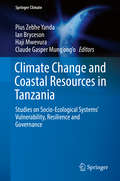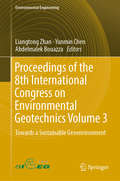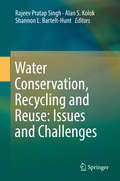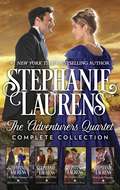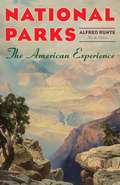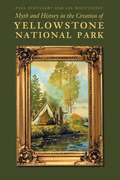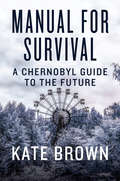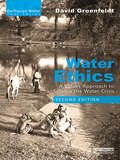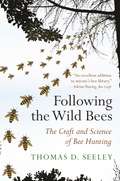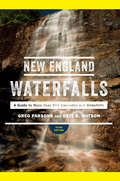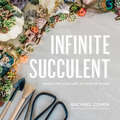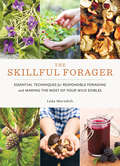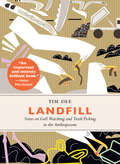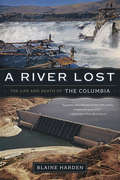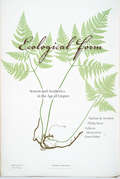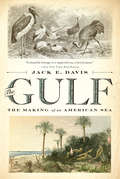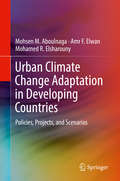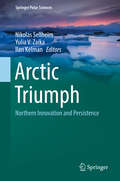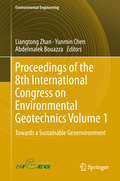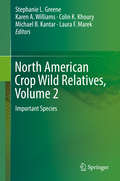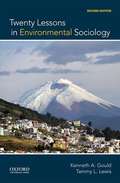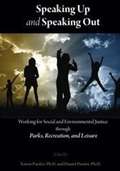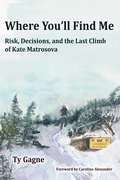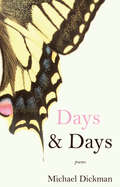- Table View
- List View
Climate Change and Coastal Resources in Tanzania: Studies on Socio-Ecological Systems’ Vulnerability, Resilience and Governance (Springer Climate)
by Pius Zebhe Yanda Ian Bryceson Haji Mwevura Claude Gasper Mung'Ong'OThis volume synthesizes research from a five year program supported by the Norwegian Agency for Development to assess how coastal communities in Tanzania can adapt to climate change impacts such as sea level rise, and better assert their rights to implement decisions regarding coastal resource management in the context of global climate change. Throughout ten chapters, the book deploys a holistic approach to adopt a conceptual model of socio-ecological systems, and characterize human-nature interactions in an integrative way to understand anthropogenic pressures on ecosystems to guide conservation and management. The book will be of interest to researchers, students studying environmental management and climate change, planners, and policy makers. The book begins by describing the biophysical and socio-economic characteristics of the Tanzanian coastal environment, then discusses the impacts of climate change on coastal resource governance, community vulnerability, and livelihood security. Then, intervention strategies are offered as a means for local communities to not only adapt to climate change impacts, but also to engage in decision-making processes to assess vulnerabilities and address challenges and limitations through educated measures. The final chapters discuss the vulnerability and adaptation of coastal communities to climate change impacts to assess how livelihoods are constructed in response to impacts, and summarize the key findings to determine the best adaptation strategies to improve adaptive capacity and reduce socio-economic vulnerability.
Proceedings of the 8th International Congress on Environmental Geotechnics Volume 3: Towards a Sustainable Geoenvironment (Environmental Science and Engineering)
by Liangtong Zhan Yunmin Chen Abdelmalek BouazzaThis book gathers selected papers presented at the 8th International Congress on Environmental Geotechnics (ICEG), held on October 28 - November 1, 2018 in Hangzhou, China. The theme of the congress is “Towards a Sustainable Geoenvironment”, which means meeting the needs of the present generation without compromising the ability of future generations to meet their own needs. Under this theme, the congress covers a broad range of topics and provides an excellent opportunity for academics, engineers, scientists, government officials, regulators, and planners to present, discuss and exchange notes on the latest advances and developments in the research and application of environmental geotechnics.
Water Conservation, Recycling and Reuse: Issues and Challenges
by Rajeev Pratap Singh Alan S. Kolok Shannon L. Bartelt-HuntWater - a basic element of life, livelihood, food security and sustainable development - holds the key to global sustainability. The global water demand has been increased 3-fold in the past five decades and only 0.4% of the total world’s fresh water resources is available and accessible for use. The United Nations projected that half of all countries will face water scarcity by 2025 and more than one-third of the world’s population could be affected by water stress by 2050. The water problem is rapidly intensifying in the Asian region, and around 700 million people do not have access to safe drinking water. Similarly, according to the Intergovernmental Panel on Climate Change (IPCC) report, by 2050, more than one billion people in Asia alone are projected to experience negative impacts on water resources as a result of climate change. Climate change is also putting extra pressure on and adversely affecting the global water cycle, leading to irregular precipitation, more floods and droughts and creating an imbalance between water supply and demand. The availability of safe water is a major global concern due to the rapidly increasing population, urbanization, unsustainable consumption patterns, and rapid shifts in land use. It is believed that reduced access to freshwater will have cascading consequences that will pose threat to global food security, livelihood security, and cause large scale migration and economic and geopolitical tensions. As such, strategies for water conservation, wastewater reuse and recycling should be adopted in order to lessen the gap between supply and demand for water for different activities. This book provides readers with a better understanding of the water security challenges, and presents innovations to address these challenges, strengthen the science-policy interface, and develop institutional and human capacities for water security and sustainability.
The Adventurers Quartet Complete Collection: An Anthology (The Adventurers Quartet)
by Stephanie LaurensStephanie Laurens, #1 New York Times bestselling author of the beloved Cynster novels, brings you THE ADVENTURERS QUARTET, a riveting blend of Regency-era high seas adventure, a mystery shrouded in the heat of tropical jungles, and the passionate romances of four couples and their unexpected journeys into love. Now together in one complete collection!The Lady’s CommandDeclan Frobisher, scion of a seafaring dynasty, is accustomed to getting his way. But his new bride, Lady Edwina Delbraith is unconventional and has a spine of steel. Bare weeks into their honeymoon, Declan is recruited to sail on a secret mission, and Edwina—naturally—declares she must accompany him. Facing unforeseen perils and unexpected enemies while battling to expose a dastardly scheme, Declan and Edwina discover that their tempestuous marriage demands something they both possess—bold and adventurous hearts. A Buccaneer at HeartWhen an urgent summons from the Crown arrives, Captain Robert Frobisher agrees to set sail for Freetown immediately. His covert mission is to locate a slavers’ camp and return to London with the information. Miss Aileen Hopkins is determined to find her brother, a naval lieutenant who has mysteriously disappeared, and she will not allow anyone to turn her from this dangerous path. Joining forces with Aileen, Robert vows to complete his task and secure the woman he wants as his wife. Compelled to protect the innocent and bring retribution to a heartless enemy, they plunge into the jungle with only each other to rely on, and the courage of their hearts as their guide. The Daredevil SnaredCaptain Caleb Frobisher, hedonistic youngest son of a seafaring dynasty, has something to prove. So he seizes the next leg of the covert mission his brothers are pursuing, and stays on to accomplish its ultimate goal. Katherine Fortescue fled a life of poverty and came to Freetown as a governess, only to be kidnapped and forced to oversee the child workforce at a mine. Guarded by mercenaries, the captives have lost all hope. Then Katherine meets Caleb—and he brings the sweet promise of rescue. Through the clashes that follow, he becomes the leader he was destined to be, and the sort of man Katherine can trust—with her body, with her life. With her love. Lord of the PrivateersRoyd Frobisher is set to execute the final stage of the rescue mission his brothers have begun. What he does not expect is to bring Isobel Carmichael, his childhood sweetheart, with him. Isobel has her own mission: to find and bring a young cousin safely home. Following a full-scale rescue-assault on the slavers’ compound deep in the jungle, Royd and Isobel discover that freeing the captives is only half the battle. To identify and convict the conspirators behind the illicit enterprise—and save England from political disaster—they must return to the ballrooms of the haut ton and hunt the villains on their home ground. But having found each other again, how much are Royd and Isobel willing to risk in the name of duty?Be swept away by all four stories in the THE ADVENTURERS QUARTET box set.
National Parks: The American Experience
by Alfred RunteThe National Parks: America's Best Idea," Alfred Runte is renowned as the nation's leading historian on the meaning and management of these treasured lands. Lavishly illustrated with period photographs, including eight pages of color paintings, National Parks: The American Experience has never been more beautiful or profound. This remains a stirring look into the lands that define America, from Yosemite and Yellowstone to wilderness Alaska.
Ragged Anthem (Made in Michigan Writers Series)
by Chris DombrowskiRagged Anthem displays the same inimitable voice and unflinching gaze that made Chris Dombrowski a Poetry Foundation bestseller and silver medal winner of Foreword Reviews’ Book of the Year Award in poetry. His work has been celebrated by renowned writers such as Jim Harrison and Alicia Ostriker, who have called his books (respectively) "extraordinarily powerful and graceful" and "one of the most beautiful books of poetry I’ve read in years." As in Dombrowski’s previous books, in Ragged Anthem the natural world is as alive and as fully realized as language allows. His comfort with the naming of the world, combined with a life lived intimately with the other species that populate the landscape of home, suggest an authenticity that few can claim. Ragged Anthem is a demonstration in continued poetic growth and expanded terrain. Written from the speaker’s midlife, the poems delve into the transformation of family, childhood tragedies, and politics. Dombrowski lifts the veil on the imbecilic bureaucracies—those on Capitol Hill and in the faculty meetings occurring in our own conference rooms—that often help to whittle our fates. The book contains well-placed and evocative allusions to such figures as American painter Mark Rothko and Saint Francis of Assisi, as well as the periodic highlighting of language from contemporary song lyrics. These "borrowings" set forth a conversation between the poet and other artists that evoke the original source while transforming it into something new, proving that words, although artifice, live within our bodies, changing our relationship to place. Ragged Anthem makes a powerful and important contribution to contemporary poetry. Fans of Dombrowski’s past works and newcomers alike will bask in the poet’s firm yet relaxed approach to the shaping of language.
Myth and History in the Creation of Yellowstone National Park
by Paul Schullery Lee WhittleseyYellowstone National Park, a global icon of conservation and natural beauty, was born at the most improbable of times: the American Gilded Age, when altruism seemed extinct and society’s vision seemed focused solely on greed and growth. Perhaps that is why the park’s “creation myth” recounted how a few saintlike pioneer conservationists labored to set aside this unique wilderness against all odds, when in fact, the establishment of Yellowstone was the result of complex social, scientific, economic, and aesthetic forces. Paul Schullery and Lee Whittlesey, both longtime students of Yellowstone’s complex history, present the first full account of how the fairy-tale origins of the park found universal public acceptance, and of the long process by which the myth was reconsidered and replaced with a more realistic and ultimately more satisfying story.
Manual for Survival: A Chernobyl Guide To The Future
by Kate BrownA chilling exposé of the international effort to minimize the health and environmental consequences of nuclear radiation in the wake of Chernobyl. Dear Comrades! Since the accident at the Chernobyl power plant, there has been a detailed analysis of the radioactivity of the food and territory of your population point. The results show that living and working in your village will cause no harm to adults or children. So began a pamphlet issued by the Ukrainian Ministry of Health—which, despite its optimistic beginnings, went on to warn its readers against consuming local milk, berries, or mushrooms, or going into the surrounding forest. This was only one of many misleading bureaucratic manuals that, with apparent good intentions, seriously underestimated the far-reaching consequences of the Chernobyl nuclear catastrophe. After 1991, international organizations from the Red Cross to Greenpeace sought to help the victims, yet found themselves stymied by post-Soviet political circumstances they did not understand. International diplomats and scientists allied to the nuclear industry evaded or denied the fact of a wide-scale public health disaster caused by radiation exposure. Efforts to spin the story about Chernobyl were largely successful; the official death toll ranges between thirty-one and fifty-four people. In reality, radiation exposure from the disaster caused between 35,000 and 150,000 deaths in Ukraine alone. No major international study tallied the damage, leaving Japanese leaders to repeat many of the same mistakes after the Fukushima nuclear disaster in 2011. Drawing on a decade of archival research and on-the-ground interviews in Ukraine, Russia, and Belarus, Kate Brown unveils the full breadth of the devastation and the whitewash that followed. Her findings make clear the irreversible impact of man-made radioactivity on every living thing; and hauntingly, they force us to confront the untold legacy of decades of weapons-testing and other nuclear incidents, and the fact that we are emerging into a future for which the survival manual has yet to be written.
Water Ethics: A Values Approach to Solving the Water Crisis (Earthscan Water Text)
by David GroenfeldtFully revised and updated, this second edition of Water Ethics continues to consolidate water ethics as a key dimension of water-related decisions. The book introduces the idea that ethics are an intrinsic dimension of any water policy, program, or practice, and that understanding what ethics are being acted out in water policies is fundamental to an understanding of water resource management. Alongside updated references and the introduction of discussion questions and recommended further reading, this new edition discusses in depth three significant developments since the publication of the first edition in 2013. The first is the growing awareness of the climate crisis as an existential threat, and associated concern about adaptive strategies for sustainable water management and ways of using water management for climate mitigation (e.g., practically through agricultural soil management and conceptually through ethics awareness). Second, there has been increased clarity among the religious community, Indigenous leaders, and progressive academics that ethics needs to become an arena for application and action (e.g., the Vatican encyclical Laudato Si, protests at Standing Rock and Flint, Michigan, in the US, and climate demonstrations worldwide). Thirdly, there have been new normative water standards ranging from "water stewardship" (industry initiative), water charters (Berlin) and the on-going initiative to develop a global water ethics charter. Drawing on case studies from countries including Australia, India, the Philippines, South Africa, and the United States, this textbook is essential reading for students of environmental ethics and water governance and management.
Following the Wild Bees: The Craft and Science of Bee Hunting
by Thomas D. SeeleyA how-to book on an exhilarating outdoor activity and a unique meditation on the pleasures of the natural worldFollowing the Wild Bees is a delightful foray into the pastime of bee hunting, an exhilarating outdoor activity that used to be practiced widely but which few people know about today. Weaving informative discussions of bee biology with colorful anecdotes, personal insights, and beautiful photos, Thomas Seeley describes the history and science behind this lost pastime and how anyone can do it. The bee hunter’s reward is a thrilling encounter with nature that challenges mind and body while also giving insights into the remarkable behavior of honey bees living in the wild. Whether you’re a bee enthusiast or just curious about the natural world, this book is the ideal companion for newcomers to bee hunting and a rare treat for armchair naturalists.
New England Waterfalls (Third Edition): A Guide To More Than 500 Cascades And Waterfalls
by Greg Parsons Kate B. WatsonHundreds of beautiful waterfalls and swimming holes across New England Lovers of all nature, Greg Parsons and Kate Watson are particularly fascinated with waterfalls. This new edition contains dozens of new waterfalls and provides extensive trail and road updates to existing ones. Waterfalls in every New England state are described according to type, height, trail length, and difficulty. Also included in this edition for the first time are color photographs, GPS coordinates for both the trailhead and the waterfall, and the size of the watershed area. With easy- to- follow maps and appendices of the best swimming holes and day trips, New England Waterfalls delivers a wealth of information for seekers of these regional treasures.
Infinite Succulent: Miniature Living Art To Keep Or Share
by Rachael CohenTake your succulents to the next level with these stylish and creative projects From blue- green to purple and pink, flower-shaped to squat and spiky or tall and fuzzy, the variety, versatility, and low-maintenance care of succulents makes them go-to plants for home gardeners. Here, succulent stylist Rachael Cohen shows that these traits also make succulents the ideal material for living art. Tiny, jewel-like succulents can be clipped and replanted in infinite combinations, and unlike cut flowers, they thrive in these arrangements. When planted in corks, they become charming living magnets; when placed in seashells, they are a delightful reminder of a day at the beach. Succulents can also grow nestled in moss, creating an opportunity for even more creativity: arrange them atop mini pumpkins or adorn a headband or a tiny wreath. In addition to illustrated step-by-step instructions for more than a dozen crafts, Cohen explains which succulents are best for each project, how to clip and prepare rosettes and leaves, and what to do when the plants outgrow their art pieces. Lush photographs throughout capture the natural beauty of the plants and boundless range of possible creations.
The Skillful Forager: Essential Techniques for Responsible Foraging and Making the Most of Your Wild Edibles
by Leda MeredithThe Skillful Forager is the ultimate forager’s guide to working with any wild plant in the field, kitchen, or pantry. From harvesting skills that will allow you to gather from the same plant again and again to highlighting how to get the most out of each and every type of wild edible, trusted expert Leda Meredith explores the most effective ways to harvest, preserve, and prepare all of your foraged foods. Featuring detailed identification information for over forty wild edibles commonly found across North America, the plant profiles in this book focus on sustainable harvesting techniques that can be applied to hundreds of other plants. This indispensable reference also provides simple recipes that can help you make the most of your harvest each season.
Landfill: Notes on Gull Watching and Trash Picking in the Anthropocene
by Tim DeeOver the past hundred years, gulls have been brought ashore by modernity. They now live not only on the coasts but in our slipstream following trawlers, barges, and garbage trucks. They are more our contemporaries than most birds, living their wild lives among us in towns and cities. In many ways they live as we do, walking the built-up world and grabbing a bite where they can. Yet this disturbs us. We’ve started fearing gulls for getting good at being among us. We see them as scavengers, not entrepreneurs; ocean-going aliens, not refugees. They are too big for the world they have entered. Their story is our story too. Landfill is the original and compelling story of how in the Anthropocene we have learned about the natural world, named and catalogued it, and then colonized it, planted it, or filled it with our junk. While most other birds have gone in the opposite direction, hiding away from us, some vanishing forever, gulls continue to tell us how the wild can share our world. For these reasons Landfill is the nature book for our times, groundbreaking and genre-bending. Without nostalgia or eulogy, it kicks beneath the littered surface of the things to discover stranger truths.
A River Lost: The Life and Death of the Columbia (Revised and Updated)
by Blaine Harden"Superbly reported and written with clarity, insight, and great skill." --Washington Post Book World After two decades, Washington Post journalist Blaine Harden returned to his small-town birthplace in the Pacific Northwest to follow the rise and fall of the West's most thoroughly conquered river. To explore the Columbia River and befriend those who collaborated in its destruction, he traveled on a monstrous freight barge sailing west from Idaho to the Grand Coulee Dam, the site of the river's harnessing for the sake of jobs, electricity, and irrigation. A River Lost is a searing personal narrative of rediscovery joined with a narrative of exploitation: of Native Americans, of endangered salmon, of nuclear waste, and of a once-wild river. Updated throughout, this edition features a new foreword and afterword.
Ecological Form: System and Aesthetics in the Age of Empire
by Monique Allewaert Sukanya Banerjee Adam Grener Deanna K. Kreisel Elizabeth Carolyn Miller Benjamin Morgan Aaron Rosenberg Teresa Shewry Jesse Oak Taylor Lynn Voskuil Karen Pinkus Philip Steer Nathan K. HensleyEcological Form brings together leading voices in nineteenth-century ecocriticism to suture the lingering divide between postcolonial and ecocritical approaches. Together, these essays show how Victorian thinkers used aesthetic form to engage problems of system, interconnection, and dispossession that remain our own. The authors reconsider Victorian literary structures in light of environmental catastrophe; coordinate “natural” questions with sociopolitical ones; and underscore the category of form as a means for generating environmental—and therefore political—knowledge. Moving from the elegy and the industrial novel to the utopian romance, the scientific treatise, and beyond, Ecological Form demonstrates how nineteenth-century thinkers conceptualized the circuits of extraction and violence linking Britain to its global network. Yet the book’s most pressing argument is that this past thought can be a resource for reimagining the present.
The Gulf: The Making of An American Sea
by Jack E. Davis<P>The tragic collision between civilization and nature in the Gulf of Mexico becomes a uniquely American story in this environmental epic. <P>When painter Winslow Homer first sailed into the Gulf of Mexico, he was struck by its "special kind of providence." Indeed, the Gulf presented itself as America’s sea—bound by geography, culture, and tradition to the national experience—and yet, there has never been a comprehensive history of the Gulf until now. And so, in this rich and original work that explores the Gulf through our human connection with the sea, environmental historian Jack E. Davis finally places this exceptional region into the American mythos in a sweeping history that extends from the Pleistocene age to the twenty-first century. <P>Significant beyond tragic oil spills and hurricanes, the Gulf has historically been one of the world's most bounteous marine environments, supporting human life for millennia. Davis starts from the premise that nature lies at the center of human existence, and takes readers on a compelling and, at times, wrenching journey from the Florida Keys to the Texas Rio Grande, along marshy shorelines and majestic estuarine bays, profoundly beautiful and life-giving, though fated to exploitation by esurient oil men and real-estate developers. <P>Rich in vivid, previously untold stories, The Gulf tells the larger narrative of the American Sea—from the sportfish that brought the earliest tourists to Gulf shores to Hollywood’s engagement with the first offshore oil wells—as it inspired and empowered, sometimes to its own detriment, the ethnically diverse groups of a growing nation. Davis' pageant of historical characters is vast, including: the presidents who directed western expansion toward its shores, the New England fishers who introduced their own distinct skills to the region, and the industries and big agriculture that sent their contamination downstream into the estuarine wonderland. Nor does Davis neglect the colorfully idiosyncratic individuals: the Tabasco king who devoted his life to wildlife conservation, the Texas shrimper who gave hers to clean water and public health, as well as the New York architect who hooked the “big one” that set the sportfishing world on fire. <P>Ultimately, Davis reminds us that amidst the ruin, beauty awaits its return, as the Gulf is, and has always been, an ongoing story. Sensitive to the imminent effects of climate change, and to the difficult task of rectifying grievous assaults of recent centuries, The Gulf suggests how a penetrating examination of a single region's history can inform the country's path ahead. <P><b>Winner of the 2018 Pulitzer Prize for History</b>
Urban Climate Change Adaptation in Developing Countries: Policies, Projects, and Scenarios
by Mohsen M. Aboulnaga Amr F. Elwan Mohamed R. ElsharounyThis book describes the risks, impacts, measures, actions and adaptation policies that have developed globally as a result of the severe impacts of global climate change. In-depth chapters focus on climate change assessment (CCA) in terms of vulnerabilities and reflection on the built environment and measures and actions for infrastructure and urban areas. Adaptation actions specific to developing countries such as Egypt are presented and illustrated. Global Climate change adaptation projects (CCAPs) in developing countries, in terms of their targets and performance, are presented and compared with those existing CCAPs in Egypt to draw learned lessons. Climate change scenarios 2080 using simulations are portrayed and discussed with emphasis on a case-study model from existing social housing projects in hot-arid urban areas in Cairo; in an effort to put forward an assessment and evaluation of current CCA techniques. This book helps researchers realize the global impacts of climate change on the built environment and economic sectors, and enhances their understanding of current climate change measures, actions, policies, projects and scenarios.Reviews and illustrates the impact of global climate change risks;Provides an understanding of global climate change risks in seven continents;Illustrates policies and action plans implemented at the global level and developing countries' level;Discusses climate change assessment and vulnerabilities with emphasis on urban areas;Presents measures and action plans to mitigate climate change scenarios by 2080.
Arctic Triumph: Northern Innovation and Persistence (Springer Polar Sciences)
by Nikolas Sellheim Yulia V. Zaika Ilan KelmanThis book approaches the challenges the Arctic has faced and is facing through a lens of opportunity. Through pinpointed examples from and dealing with the Circumpolar North, the Arctic is depicted as a region where people and peoples have managed to endure despite significant challenges at hand. This book treats the ‘Arctic of disasters’ as an innovated narrative and asks how the ‘disaster pieces’ of Arctic discourse interact with the ability of Arctic peoples, communities and regions to counter disaster, adversity, and doom. While not neglecting the scientifically established challenges associated with climate change and other (potentially) disastrous processes in the north, this book calls for a paradigm shift from perceiving the ‘Arctic of disasters’ to an ‘Arctic of triumph’. Particular attention is therefore given to selected Arctic achievements that underline ‘triumphant’ developments in the north, even when Arctic triumph and disaster intersect.
Proceedings of the 8th International Congress on Environmental Geotechnics Volume 1: Towards a Sustainable Geoenvironment (Environmental Science and Engineering)
by Liangtong Zhan Yunmin Chen Abdelmalek BouazzaThis book gathers selected papers presented at the 8th International Congress on Environmental Geotechnics (ICEG), held on October 28 - November 1, 2018 in Hangzhou, China. The theme of the congress is “Towards a Sustainable Geoenvironment”, which means meeting the needs of the present generation without compromising the ability of future generations to meet their own needs. Under this theme, the congress covers a broad range of topics and provides an excellent opportunity for academics, engineers, scientists, government officials, regulators, and planners to present, discuss and exchange notes on the latest advances and developments in the research and application of environmental geotechnics.
North American Crop Wild Relatives, Volume 2: Important Species
by Stephanie L. Greene Karen A. Williams Colin K. Khoury Michael B. Kantar Laura F. MarekThe plant species that humans rely upon have an extended family of wild counterparts that are an important source of genetic diversity used to breed productive crops. These wild and weedy cousins are valuable as a resource for adapting our food, forage, industrial and other crops to climate change. Many wild plant species are also directly used, especially for revegetation, and as medicinal and ornamental plants. North America is rich in these wild plant genetic resources. This book is a valuable reference that describes the important crop wild relatives and wild utilized species found in Canada, the United States and Mexico. The book highlights efforts taken by these countries to conserve and use wild resources and provides essential information on best practices for collecting and conserving them. Numerous maps using up-to-date information and methods illustrate the distribution of important species, and supplement detailed description on the potential value these resources have to agriculture, as well as their conservation statuses and needs. There is broad recognition of the urgent need to conserve plant diversity; however, a small fraction of wild species is distinguished by their potential to support agricultural production. Many of these species are common, even weedy, and are easily overshadowed by rare or endangered plants. Nevertheless, because of their genetic proximity to agriculturally important crops or direct use, they deserve to be recognized, celebrated, conserved, and made available to support food and agricultural security. This comprehensive two-volume reference will be valuable for students and scientists interested in economic botany, and for practitioners at all levels tasked with conserving plant biodiversity.
Twenty Lessons in Environmental Sociology
by Kenneth A. Gould Tammy L. LewisTwenty Lessons in Environmental Sociology introduces undergraduates to the topic in an innovative way. Instead of compiling articles from professional journals, this reader presents twenty classroom-tested "lessons" from dedicated, experienced teachers and researchers in the field.
Speaking Up and Speaking Out: Working for Social and Environmental Justice through Parks, Recreation, and Leisure
by Karen Paisley Daniel DustinWho speaks up for the disadvantaged? Who speaks out for the disenfranchised? Who safeguards the rights of the dispossessed? Speaking Up and Speaking Out explores the role of parks, recreation, and leisure in promoting social and environmental justice.
Where You'll Find Me: Risk, Decisions, and the Last Climb of Kate Matrosova
by Ty Gagne T. B. R. WalshOn Feb. 15, 2015, Kate Matrosova, an avid mountaineer, set off before sunrise for a traverse of the Northern Presidential Range in New Hampshire’s White Mountains. Late the following day, rescuers carried her frozen body out of the mountains amid some of the worst weather ever recorded on these deceptively rugged slopes. <P><P>At thirty-two, Matrosova was ultra-fit and healthy and had already summited much larger mountains on several continents. Her gear included a rescue beacon and a satellite phone. Yet, despite their best efforts, more than forty expert search and rescue personnel, a New Hampshire Army National Guard Blackhawk helicopter, and a Civil Air Patrol Cessna airplane could not reach her in time to save her. <P><P>What went wrong? <P><P>Where You’ll Find Me offers possible answers to that question, demonstrating why Matrosova’s story—what we know and what we will never know—represents such an intriguing and informative case study in risk analysis and decision-making.
Days & Days: Poems
by Michael DickmanAn exhilarating and far-ranging meditation on days and how we live in them in the twenty-first century, from the award-winning poet.Michael Dickman's intuitive, agile verse captures us in its unusual pulse. Image-driven and shape-driven, the poems of Days & Days touch on parenthood, childhood, local natural habitats, graffiti culture, roses, and romantic love. Dickman considers both the internal and external vistas that open before him in the course of a day, the memories and the immediate quandaries. The long centerpiece poem, "Lakes Rivers Streams," is a reverie that picks up the flotsam of parenting days on its current. Other poems account for hotel days, or days spent watching TV, taking prescription drugs, watching butterflies. Throughout, we feel the dazzling originality of Dickman's awareness; he meets the brutality, banality, and strange beauty of the quotidian with a level gaze, and with an urgent musicality that carries us beyond these lines and pages.
